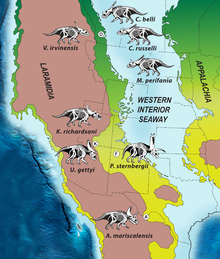Cosmoceratops
| Cosmoceratops | ||||||||||||
|---|---|---|---|---|---|---|---|---|---|---|---|---|

Live reconstruction of Kosmoceratops |
||||||||||||
| Temporal occurrence | ||||||||||||
| 76.4 to 72 million years | ||||||||||||
| Locations | ||||||||||||
|
||||||||||||
| Systematics | ||||||||||||
|
||||||||||||
| Scientific name | ||||||||||||
| Cosmoceratops | ||||||||||||
| Sampson et al., 2010 | ||||||||||||
Kosmoceratops ("decorated horn face") is an extinct genus of pelvic dinosaurs from the group of Ceratopsia or from their subgroup Chasmosaurinae . Kosmoceratops lived during the Upper Cretaceous (late Campanium ) in the area of what is now Utah (USA); their fossils wereuncoveredin the Kaiparowits Formation . The holotype belongingto the species Kosmoceratops richardsoni was discovered in 2010 by Sampson et al. described.
description
Kosmoceratops was a quadruped herbivore that reached a length of up to five meters at a height of 1.8 meters. The animals probably weighed up to 2.5 tons. Kosmoceratops wore a two-meter tall, horned skull. He had fifteen horns: ten on his ruff, one above his eyes, one on his nose, and one on each cheek. There are various theories among paleontologists about the purpose of the eponymous headdress, including the regulation of body temperature, the easy recognition of members of the own species and the defense against predators. The most likely theory at the moment is that the headdress was used during mating as part of the impressive behavior .
Systematics
The systematics of the Chasmosaurinae including the Kosmoceratops according to Caleb Brown and Donald Henderson from 2015 is shown below:
| Chasmosaurinae |
|
||||||||||||||||||||||||||||||||||||||||||||||||||||||||||||||||||||||||||||||||||||||||||||||||||||||||||||||||||||||||
|
|
Paleoecology
The Chasmosaurinae to which Kosmoceratops belonged have only been found in western North America. This area was part of the Laramidia land mass during the Upper Cretaceous , to which the Chasmosaurinae were believed to be endemic . Laramidia's climate was largely subtropical, with wide coastal plains and swamps. Kosmoceratops shared its habitat with another ceratopsier named Utahceratops and the more distantly related Nasutoceratops . Furthermore, Hadrosauridae such as Parasaurolophus and Gryposaurus came before. Kosmoceratops was probably hunted by Tyrannosauridae such as the Teratophoneus . Younger specimens could also have served as prey for Troodontidae such as Talos .
Individual evidence
- ↑ Ashu Khosla, Spencer G. Lucas (Ed.): Cretaceous Period: Biotic Diversity and Biogeography: Bulletin 71 . Albuquerque, New Mexico 2016, pp. 206 .
- ↑ Kosmoceratops richardsoni. In: dinodata.de. Retrieved July 16, 2018 .
- ↑ Caleb M. Brown, Donald M. Henderson: A new horned dinosaur reveals convergent evolution in cranial ornamentation in ceratopsidae . In: Current Biology . No. June 25 , 2015.
- ^ Scott D. Sampson: Dinosaur Research. In: scottsampson.net. Retrieved July 16, 2018 .
- ↑ Cosmoceratops. In: prehistoric-wildlife.com. Retrieved July 16, 2018 .


